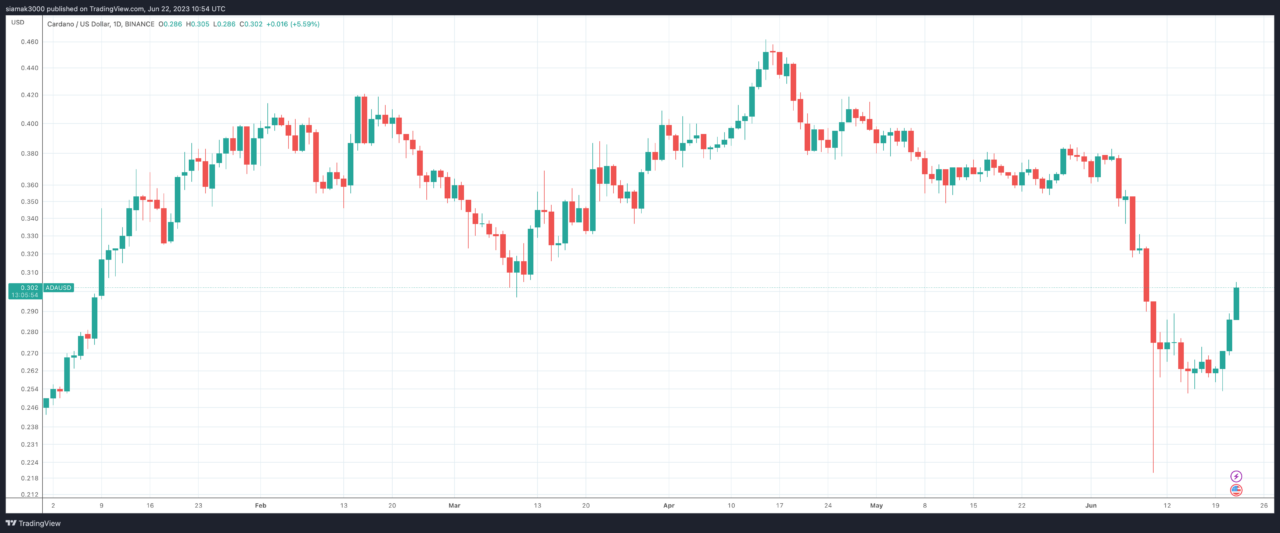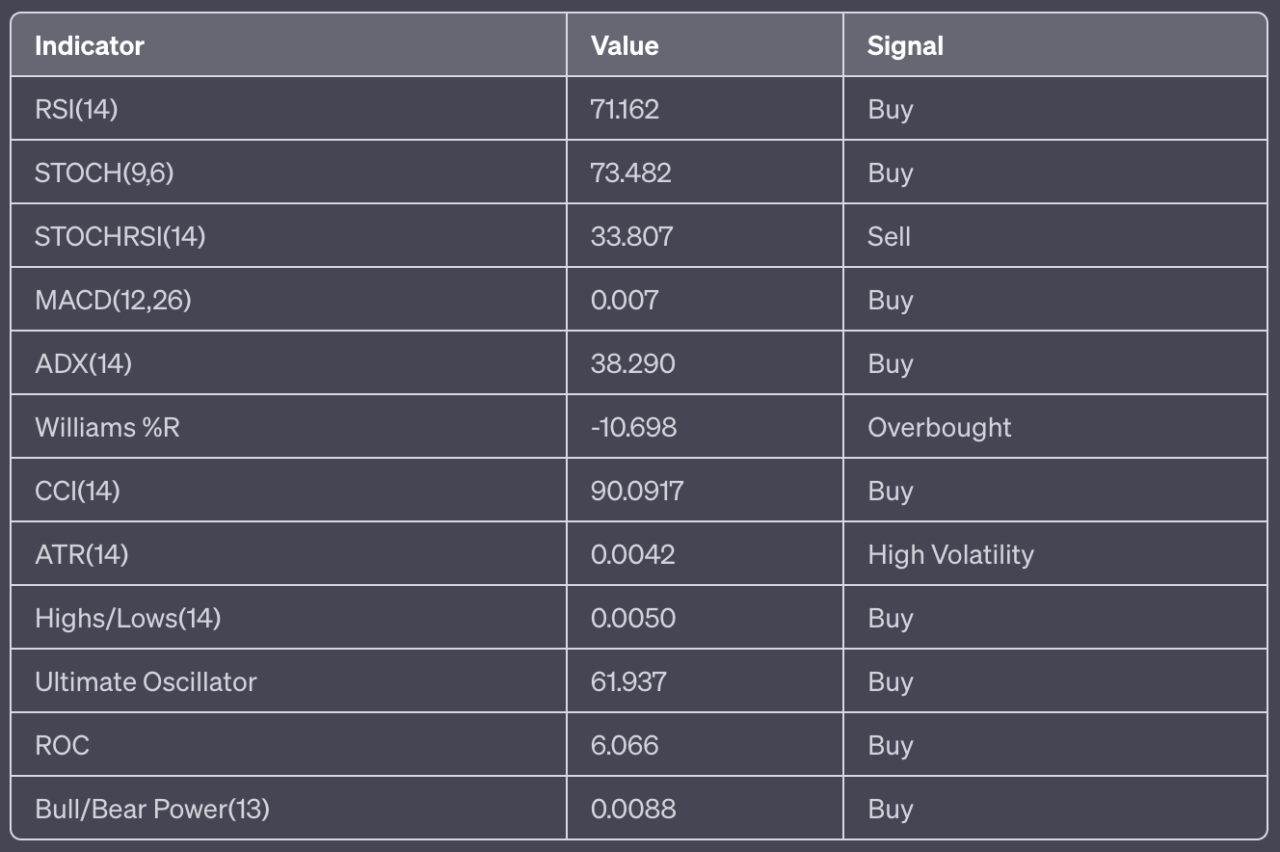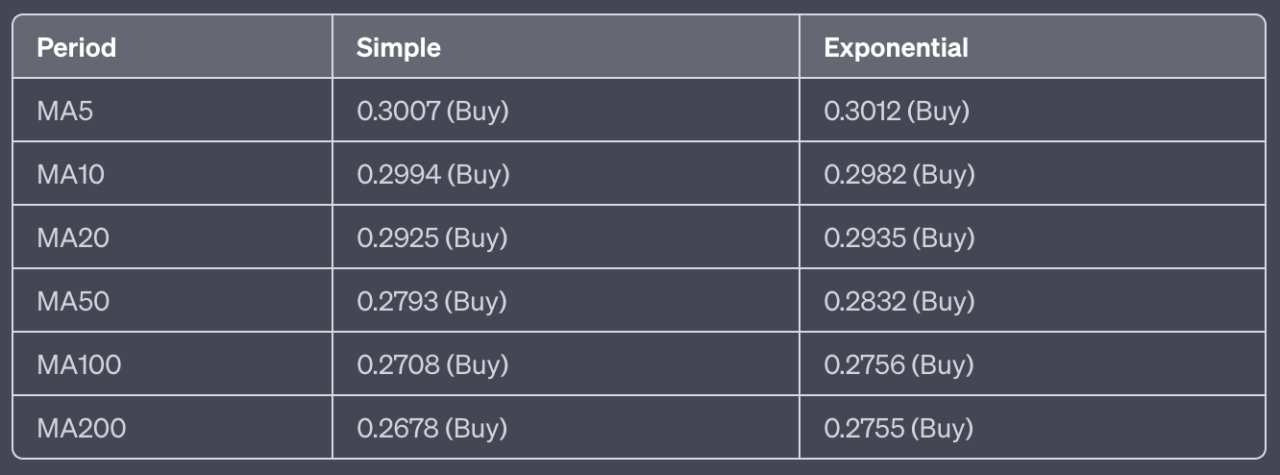Introduction
This report provides a comprehensive analysis of Cardano (ADA) for 22 June 2023. The data includes real-time price, volume, bid/ask, day’s range, technical indicators, and moving averages.
Price and Volume Overview
As of 10:35 a.m. on 22 June 2023, on Binance, Cardano is trading at $0.3027, up by 8.49% from its previous close. The trading volume over the last 24 hours was 198,595,918 ADA. The bid price is $0.3027, and the ask price is $0.3028. The day’s range is between $0.2757 and $0.3049.

Technical Indicators
Technical indicators are used to predict future price movements and market trends.
Here’s a detailed breakdown of the technical indicators for Cardano (ADA):
RSI(14): The 14-day Relative Strength Index is 71.162, indicating a buy condition. The RSI measures the speed and change of price movements on a scale of 0 to 100. Traditionally, the asset is considered overbought when the RSI is above 70 and oversold when it’s below 30. In this case, ADA is nearing an overbought condition, suggesting a potential price correction in the future.
STOCH(9,6): The Stochastic Oscillator is 73.482, indicating a buy condition. This momentum indicator compares a particular closing price of the asset to a range of its prices over a certain period of time. The current value suggests that ADA is closer to its highs than its lows, which is typically viewed as a bullish signal.
STOCHRSI(14): The Stochastic RSI is 33.807, indicating a sell condition. This is a technical momentum indicator that compares the level of the RSI to its high-low range over a set time period. A low value could indicate a buying opportunity as the price might increase soon.
MACD(12,26): The Moving Average Convergence Divergence is 0.007, indicating a buy position. The MACD is a trend-following momentum indicator that shows the relationship between two moving averages of a security’s price. The MACD line crossing above the signal line can be a bullish signal, and when it crosses below, it can be a bearish signal. In this case, the MACD line is above the signal line, indicating a bullish signal.
ADX(14): The Average Directional Index is 38.290, indicating a buy position. The ADX is used to measure the strength or weakness of a trend, not the actual direction. Values below 20 are often associated with non-trending markets, and values above 25 may indicate a trend.
Williams %R: The Williams %R is -10.698, indicating an overbought condition. This momentum indicator measures overbought and oversold levels. Readings range from 0 to -100, with -50 as the middle line. Readings above -20 are considered overbought, and readings below -80 are considered oversold. The current reading suggests that ADA is in an overbought condition.
CCI(14): The Commodity Channel Index is 90.0917, indicating a buy position. The CCI is a momentum-based oscillator used to help determine when an investment vehicle is reaching a condition of being overbought or oversold. A CCI above 100 may indicate an overbought condition, while a CCI below -100 may indicate an oversold condition.
ATR(14): The Average True Range is 0.0042, indicating high volatility. The ATR is a technical analysis indicator that measures market volatility by decomposing the entire range of an asset price for that period. Higher values typically represent higher volatility and more unstable price movements.
Highs/Lows(14): The value is 0.0050, indicating a buy position. This indicator is used to identify the highest and lowest prices for the asset over a particular period.
Ultimate Oscillator: The value is 61.937, indicating a buy position. This is a technical indicator that is used to measure momentum across multiple timeframes. A value below 30 often indicates an oversold condition, while a value above 70 indicates an overbought condition.
ROC: The Rate of Change is 6.066, indicating a buy position. The ROC is a momentum oscillator, which measures the percentage change between the current price and the n-period past price. A positive ROC indicates a bullish signal, suggesting that the price is increasing.
Bull/Bear Power(13): The value is 0.0088, indicating a buy position. These indicators measure the balance of power between bulls (buyers) and bears (sellers). A positive value indicates that bulls are in control, while a negative value indicates that bears are in control.

In summary, the technical indicators suggest a strong buy signal for Cardano, with nine buy signals and one sell signal. The overbought conditions indicated by the RSI and Williams %R could suggest a potential price correction in the near future, but the overall trend appears to be bullish.
Moving Averages
Moving averages are a type of data smoothing technique that analysts use in technical analysis to identify trends in a set of data, such as stock prices. They help to reduce the noise and fluctuation in price data to present a smoother line, making it easier to see the overall direction or trend.
There are several types of moving averages, but two of the most common ones are the Simple Moving Average (SMA) and the Exponential Moving Average (EMA).
Simple Moving Average (SMA): The SMA is calculated by adding the prices for a certain number of periods and then dividing by that number of periods. For example, a 5-day SMA would add the closing prices for the last five days and then divide by five. The SMA gives equal weight to all the data points in its calculation.
Exponential Moving Average (EMA): The EMA is similar to the SMA but gives more weight to recent data. This means it responds more quickly to recent price changes than the SMA. The calculation of the EMA is a bit more complex than the SMA, involving an exponential smoothing factor to give more weight to recent prices.
The significance of different period moving averages (like 5-day, 10-day, 20-day, 50-day, 100-day, and 200-day) lies in the timeframe that traders are interested in:
5-day, 10-day, and 20-day moving averages are often used for short-term trends. They respond quickly to price changes and are useful for traders looking to take advantage of short-term price movements. 50-day and 100-day moving averages are more medium-term. They are less sensitive to daily price fluctuations and provide a clearer picture of the medium-term trend. 200-day moving average is a long-term trend indicator. It’s less sensitive to daily price fluctuations and provides a clearer picture of the long-term trend. Many traders consider a market to be in a long-term uptrend when the price is above the 200-day moving average and in a long-term downtrend when it’s below.
It’s important to note that moving averages are lagging indicators, meaning they are based on past prices. They can help identify a trend but won’t predict future price movements.
Here’s a detailed breakdown of the moving averages for Cardano (ADA):
Simple Moving Averages (SMA):
- MA5: The 5-day SMA is at 0.3007, which is below the current price. This is typically considered a buy signal as it suggests that the price is trending upward in the short term.
- MA10: The 10-day SMA is at 0.2994, also below the current price, which reinforces the buy signal in the short term.
- MA20: The 20-day SMA is at 0.2925, which is below the current price. This is a buy signal, suggesting that the price is trending upward in the medium term.
- MA50: The 50-day SMA is at 0.2793, which is below the current price, reinforcing the buy signal in the medium term.
- MA100: The 100-day SMA is at 0.2708, which is below the current price. This is a buy signal, suggesting that the price is trending upward in the long term.
- MA200: The 200-day SMA is at 0.2678, which is below the current price. This reinforces the buy signal in the long term.
Exponential Moving Averages (EMA):
- MA5: The 5-day EMA is at 0.3012, which is below the current price. This is typically considered a buy signal as it suggests that the price is trending upward in the short term.
- MA10: The 10-day EMA is at 0.2982, also below the current price, which reinforces the buy signal in the short term.
- MA20: The 20-day EMA is at 0.2935, which is below the current price. This is a buy signal, suggesting that the price is trending upward in the medium term.
- MA50: The 50-day EMA is at 0.2832, which is below the current price, reinforcing the buy signal in the medium term.
- MA100: The 100-day EMA is at 0.2756, which is below the current price. This is a buy signal, suggesting that the price is trending upward in the long term.
- MA200: The 200-day EMA is at 0.2755, which is below the current price. This is a buy signal, suggesting that the price is trending upward in the long term.

In summary, the moving averages suggest a strong buy signal for Cardano with twelve buy signals and zero sell signals. The short-term, medium-term, and long-term trends are all bullish, indicating strong upward momentum.
Conclusion
In conclusion, the market sentiment for Cardano (ADA) as of June 22, 2023, leans towards a bullish outlook. Most technical indicators and all the moving averages suggest a “BUY” action. This implies upward pressure on the price in the short term. However, the overbought conditions indicated by the Williams %R and the high RSI value could suggest a potential price correction in the near future.
The moving averages, across all periods reinforce this bullish sentiment, all indicating a buy signal. This suggests that the overall trend for Cardano is upward, and the price is expected to increase in both the short and long term.
However, it’s worth noting that the 5-day and 10-day SMAs indicate a sell signal, which could suggest short-term price volatility. Traders should monitor these shorter-term indicators, as they could signal a potential change in the short-term trend.
As always, it’s important to note that while technical analysis tools can provide useful insights, they are not a guarantee of future performance, and all trading strategies should be used in conjunction with other market information and individual research.
Featured Image Credit: Photo / illustration by “Dylan Calluy” via Unsplash









